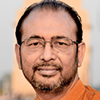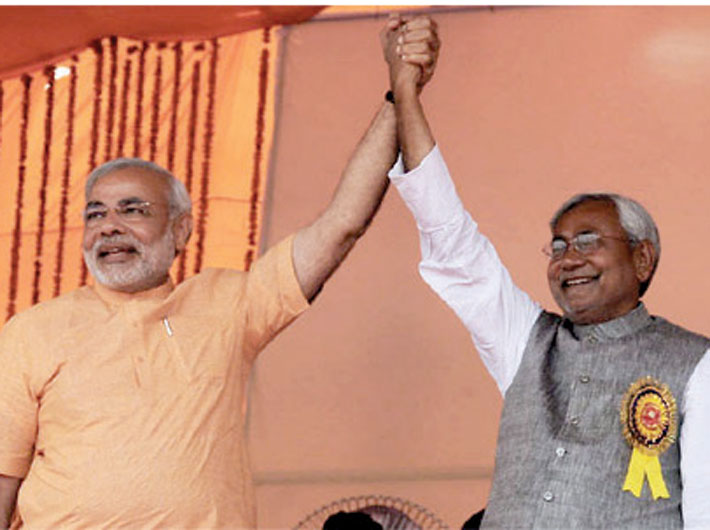Analysing Modi and Nitish’s strategies to win the top post in next general elections
Among the political high dramas of recent times, the side-plot of Narendra Modi versus Nitish Kumar has had more than a healthy share of melodrama since 2009. Besides its entertainment value, the rivalry between the two satraps has assumed significance due to the impending general elections against the backdrop of a perception that the ruling coalition has gone into a tailspin.
The foremost question, however, is the schism deep enough to result in a reconfiguration of political forces – either before the polls or subsequent to the verdict – or will the two continue taking potshots at each other while being part of the same coalition?
Evaluation of the ‘Modi-Nitish Ki Ajeeb Dastaan’ has to be done keeping a delightful irony in mind: the contrasting roles that the ‘past’ plays for the two. For Modi, the past is 2002. It is a label that will continue to stick to him till eternity, one for which he would never display remorse and will remain the ‘core’ over which he builds further to add to the ‘development man’ image.
The more the ‘mass murderer’ tag is put on him, the further it consolidates his primary support base. The past is Modi’s USP and even after eyeing a bigger national role, he has given no indication of reconciliation with religious minorities like LK Advani suggested.
Nitish projects his past as a certificate of his secular and socialist moorings, seemingly diluting, and at times obfuscating, the identity of his political allies. The Lohiaite core is the Bihar strongman’s buffer against charges of having aligned with ‘communal forces’. His pivotal position in Bihar has enabled Nitish to even dictate to the Bharatiya Janata Party’s state leaders the stance they are to take on intra-BJP matters; if Modi is suitable to become the main electoral mascot or even campaign in state polls.
When Nitish displays dislike, disregard or opposition to Modi, he also uses his political heritage to erase public memory of the fact that he was railway minister at the time of the Godhra carnage. Moreover, unlike several other leaders of the ruling coalition of that time, Nitish remained at ease with Modi and his handling by the BJP. Just as Modi believes that his core voter is the aggressive Hindu, Nitish thinks that the secular-socialist base with a fair sprinkling of minorities remain his primary support base.
For reasons of governance – and pursuit of power – both Modi and Nitish have to be accommodative. Modi does this by stringing the ‘development raga’ and Nitish pursues this by pursuit of social justice and a more ‘inclusive’ programme.
Differences start cropping up with the strategy they deploy contrastingly to do this. When Modi fires salvos at the centre, he does not seek special privileges and instead focuses on denial of the ‘rights of Gujarat’. Modi’s missives to New Delhi strengthen his macho image and do not harm interests of other states and their people by taking away anything from them.
But when Nitish set up base in Delhi for a few hours to demand ‘special status’ for his state, he did not get the support of anyone outside the Bihari diaspora. Thousands who thronged the Ramlila Maidan were primarily – if not exclusively – from Bihar. In contrast, the hundreds who thronged Shri Ram College of Commerce to listen to Modi were from across the country, owing no loyalty to any specific region or state.
In a direct Modi versus Nitish race, the support outside their respective states will be a significant factor and Modi is currently several laps ahead. But when the two have to contend with other contenders including from within the BJP, Nitish expects his perceived malleability to be a greater advantage.
The reason behind the ‘sectional following’ of the rally staged by Nitish – and his overall support base – is because the demand for ‘special status’ raises suspicion of people from other states. They fear that such a demand, if acquiesced, is likely to cut corners of the coffers of others. On the face of it, Nitish’s strategy is aimed more within Bihar – to make his position unassailable – than outside it. Beyond Bihar, Nitish’s strategy is to solely throw his hat in the ring so that if the need for a non-Congress, non-Modi (and/or non-BJP) leader crops up, his name is on top of the list.
But to be fair to both, neither is playing for the benefit of the other. The purpose of being in the game is to propel oneself to the top spot. Both have strong anti-Congress roots and despite suggestions that Nitish is keeping the option of aligning with the Grand Old Party, such a possibility appears remote since it would result in a complete reworking of alliances. This is especially true as Lalu Yadav and Ram Vilas Paswan still remain significant political players in Bihar.
Early laps of the next hustings have begun in real earnest. Nitish has a major handicap: he does not come from either of the two largest parties. It is, therefore, of paramount interest to him that the BJP does not name Modi as its electoral mascot because such a situation is either going to lead to the Janata Dal (United) breaking away or it being forced to accept Modi as the leader.
Nitish knows that he is likely to get the best shot at the prime ministership if the combined seats of the Congress and the BJP in the next Lok Sabha end up significantly less than 300. In such a situation with the two big parties getting almost 250 seats, other parties would cobble together another 1996-like political rump with either the Congress or the BJP lending a hand from outside.
As far as Modi is concerned, his hope lies in the BJP veering around to the view that the party’s chances will be the brightest with him at its helm. In the run-up to the polls, the paths of the two are not likely to be complementary to each other. Photo opportunities like the one in Ludhiana in May 2009 or at the chief minister’s meeting last year are a thing of the past.

